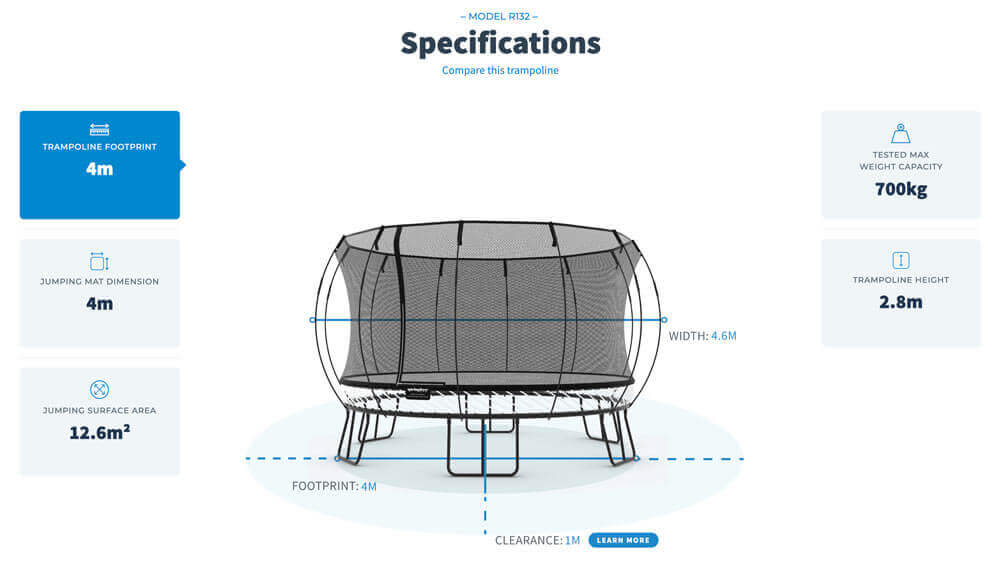The Truth About Trampoline Weight Limits | Everything You Need to Know
Are you considering buying a trampoline for your family, but unsure about the weight limit? Here’s everything you need to know so that you can make an educated decision.
5 min read

Are you considering buying a trampoline for your family but unsure about how much weight it can hold?
You’re not alone; many aspiring jumpers have questions about the weight limits on trampolines and if it’s something that needs to be strictly followed.
Spoiler alert: The weight limit of a trampoline is important, and it can lead to injury and a broken trampoline if you don’t adhere to it.
As a trampoline innovator (we created the springless trampoline) and manufacturer, we have accrued all the expertise necessary to answer your most pressing questions about trampoline weight limits, so an unfortunate scenario doesn’t become a reality.
In this article, we will go over what a trampoline’s weight limit is, the importance of following it, and examples that show how much weight a trampoline can hold, using specific trampoline models for context.
After reading this, you will have a solid understanding of a trampoline's weight limit and be able to apply it to your research process, so you get the right trampoline for you and your family.
Do Trampolines Have a Weight Limit?
Before getting into the nitty-gritty, we have to answer the most basic question surrounding the weight limit of a trampoline: Do they actually have one?
The answer is an unequivocal yes: Every trampoline ever manufactured and sold will have a maximum weight that it cannot exceed without “bottoming out,” or falling through the trampoline.
How Much Weight Can a Trampoline Hold?
So, every trampoline has a weight limit—How much can they hold?
This will depend on the type of trampoline and the specific brand you’re talking about. But there are two universal ways that trampoline brands measure the weight limits of their trampolines: Single jumper weight capacity and maximum structural weight capacity.
Both differ greatly from each other and it’s essential that you know the difference. We’ll explain:
Single Jumper Weight Capacity vs. Maximum Structural Weight
We’re going to go over an example of both metrics, but let’s first define single jumper weight capacity and maximum structural weight so you have a general understanding of the terms:
*Single Jumper Weight Capacity- Also called single user weight, the single jumper weight capacity is calculated by the manufacturer of the trampoline and is based on how heavy you are and how high you jump. It’s set to protect jumpers from ‘bottoming out’ (touching the ground while jumping) when they meet maximum height on the trampoline.
*Maximum Structural Weight- Also called structural load capacity, the maximum structural weight is the total amount of static weight a trampoline can hold without collapsing or inflicting damage to itself (i.e. rods snapping, springs breaking legs buckling, frame bending, etc.
Let’s use our Springfree Jumbo Round Trampoline to demonstrate how single jumper weight capacity differs from the maximum structural weight of a trampoline:
Springfree Jumbo Round Trampoline Weight Limit

As you can see, the Jumbo Square can hold up to 700 kg, but its single jumper weight capacity is only 100 kg. Why is this?
It’s because the 700 kg maximum structural weight is static, or how much weight you can put on the trampoline when it is at rest without bottoming out.
By this metric, you could fit a car on it without the trampoline completely bottoming out. No, really!

But this does not take into account what a trampoline is used for, which is jumping. When a person jumps on a trampoline, it creates much more downward force onto the trampoline than a static object.
The single jumper weight capacity measures how high somebody can jump, based on their weight, and still safely land without bottoming out.
Now, this doesn’t mean you can’t jump on the trampoline if you weigh more than the listed single jumper weight capacity. It just means there is an increased risk of bottoming out if you reach maximum height while jumping and weigh over the individual weight limit.
That’s why it’s crucial to follow the single jumper weight capacity and not the total structural weight. If you don’t, you run the risk of hitting the ground—which can result in an instant trip to the emergency room.
How Important Is a Trampoline’s Weight Limit?
Following the single-jumper weight limit stated by the manufacturer of the trampoline is essential to making sure all jumpers are safe from falling through the trampoline.
Imagine the pain you would feel if you jumped high in the air on a trampoline and fell to the ground or on the springs. It wouldn't feel good, to say the least.
It’s a scenario nobody wants to imagine. So, before buying a trampoline, take the single jumper weight capacity seriously. If you already have a trampoline and it is not adequate to fit the size of the jumpers, you would be best served to purchase one that can safely hold the individual weight of the jumpers.
As we’ve all heard a hundred times in our lives: It’s better to be safe than sorry.
3 Key Takeaways About Trampoline Weight Limit
We’ve gone over a lot of information in this article and some of if it is a bit technical. So, if you’re looking for the key takeaways as you look for your next trampoline, here they are:
Key Takeaway #1: All trampolines have a weight limit, and it is a hugely important factor to contemplate before buying a trampoline if safety is a priority for you.
Key Takeaway #2: Pay attention to the SINGLE JUMPER WEIGHT CAPACITY, not the maximum structural weight.
Key Takeaway #3: The specific weight limits of trampolines will vary by brand. Do your research and find one that can accommodate the weight of those that will be using the trampoline.
Springfree’s Advice: Consider the weight of all potential jumpers before buying, and if you have small children, plan for the future and buy a bigger trampoline that your child can grow into rather than grow out of.
What Else Should You Know Before Buying a Trampoline?
The weight limit of a trampoline is just one of the factors you need to consider before deciding which trampoline to purchase.
We’ve used our years of experience in the trampoline industry to narrow down the most important things you need to consider before buying a trampoline.
Read through our “7 Things to Look for When Purchasing a Trampoline” article and become informed on everything you need to know to get the perfect trampoline for your backyard!

